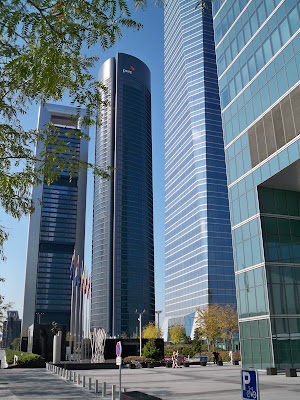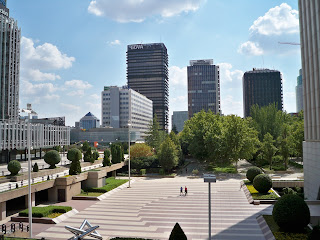The first stop of the day was the Puerta del Sol, which is literally 2 blocks from the place where we are staying (which I just remembered I need to take pictures of, because it is quite cool as well). Puerta del Sol is a super popular area, one of the most popular places in Madrid. It is a sort of meeting place for everyone, and especially when the night crowd comes out, people will just decide to meet in this plaza. It is oriented specifically to catch the sun in the east in the morning, and all of the major Spanish roads start from this point, just like how all the railroads start from the Atocha station. There is also a neat festival that happens on New Years, at midnight, when everyone eats 12 grapes for good luck for the upcoming year.
 We then hopped on the subway and went down towards a really new part of Madrid, which has the tallest skyscrapers in Spain. Honestly, this was probably my favorite part of the day. As cool as European cities are, when I think of the word city I think of towering skyscrapers and blocks crammed as close together as possible with glistening windows and such an imposing nature that you almost feel scared. This area is called the Cuatro Torres Business Area, or CTBA. It was supposed to kickstart a new business area, and was built on top of the old training grounds for the Real Madrid football team, but in many ways it failed miserably. There are 4 towers: Torre Espacio, Torre de Cristal, Torre Sacyr-Vallehermoso, and Torre Caja Madrid. Each one is unique in its own way, and as much as I'd love to post pictures of all of them (I took over 80 pictures of varying types and angles at this site alone) I'll pick 1 or 2 for you guys.
We then hopped on the subway and went down towards a really new part of Madrid, which has the tallest skyscrapers in Spain. Honestly, this was probably my favorite part of the day. As cool as European cities are, when I think of the word city I think of towering skyscrapers and blocks crammed as close together as possible with glistening windows and such an imposing nature that you almost feel scared. This area is called the Cuatro Torres Business Area, or CTBA. It was supposed to kickstart a new business area, and was built on top of the old training grounds for the Real Madrid football team, but in many ways it failed miserably. There are 4 towers: Torre Espacio, Torre de Cristal, Torre Sacyr-Vallehermoso, and Torre Caja Madrid. Each one is unique in its own way, and as much as I'd love to post pictures of all of them (I took over 80 pictures of varying types and angles at this site alone) I'll pick 1 or 2 for you guys.The Caja Madrid is the tallest skyscraper in Spain, but it almost seems like the 4 towers are competing with each other. In fact, it's quite possible, given that they were designed by all sorts of international architects. They have cutting edge technology, with things like ventilation solutions and heating/cooling solutions, in addition to things that help combat the serious wind that occurs often in Madrid.
In the one building with the hole on top of it, there were supposed to eventually be wind turbines in there to help with energy supplementation, but it never happened. This area felt so so empty; and while it was a Saturday, it seems as if the whole business district idea never caught on. The buildings are never fully occupied, and I would imagine are struggling somewhat to stay afloat. Because of this lack of demand, prices are often extremely reasonable, at the hotel in particular. Getting a 5 star hotel at 120€ a night is apparently a spectacular deal...
Before lunch we stopped at this short art exhibition of José Prouvé's work. It was kind of interesting, but I didn't really catch too many things that struck my fancy. I have to say though the best thing that I saw was not even a part of the exhibition. I bet you thought all fire extinguishers were red and cylindrical, huh? Think again!
Next we moved on to the BBVA tower. A lot of the skyscrapers in this area are in the 80's style of skyscrapers, which is a clearly noticeable difference from the modern edges and curves of today. It is in the financial district, and was done by Francisco Saenz de Oiza, who is really a big fan of using organic growth in his architecture. He purposely used something that would result in oxidation, so that the building would become a dark rich rustic brown. The curved corners are a nice touch to differentiate it from a normal skyscraper. There is also a metro line that runs directly under the building along with a parking garage. The most prevalent material is pre-stressed concrete. Unfortunately the security guard was being a total poop and therefor we didn't really get a chance to take too many pictures, with the exception of those from far away. So here is one were you can see the BBVA in the background and the rest of the neat little financial plaza around it.
The next place we went to was completely different. It seems like every place we get out of the subway in Madrid has a completely different feel, as if it were a completely different city. But anyways, this place was totally empty. Granted it was during the general siesta hour, but it was a Saturday; you would think people would be out and about, at least a little bit.
One major difference was that this housing area had literally no commercial areas. The area has 29,000 new homes for Madrid's suburbia which were built by Ecosystem Urbano. There are also some new pavilions that are meant to generate public usage, but this whole idea has almost completely failed. It's really a shame. In fact, the place literally looks like a movie set; some ghost town of a set. It felt like we were walking into a town where zombies would start popping out everywhere; it was really creepy. These pavilions were an attempt to really give the pedestrian the priority in the area, as opposed to vehicular traffic. Solar panels help with energy and all profits made from selling back to the grid are used to upkeep the space. Despite attempts to really engage the public, the space simply doesn't work.
The last place that we stopped was at the Reina Sofia museum, located right next to the Atocha rail station where we originally came in to Madrid. It originally used to be a hospital and after many renovations was turned into a contemporary art museum. Originally this was a temporary space for the art, but in the 1980's it became the permanent home of contemporary art, basically taking the rest of the time periods that the famed El Prado museum didn't have. A British architect got most of the credit for renovations, though it is technically still under construction. The most important part that we talked about was the new mix of a semi-overwhelming bright red structure that covers the already existing walls of the hospital. This next extension was meant to create a balanced union between the old and new building, but in my opinion, it is a tad heavy. Here are a few pictures from the last visit:









No comments:
Post a Comment
Would love to hear what you are thinking. Leave a comment!